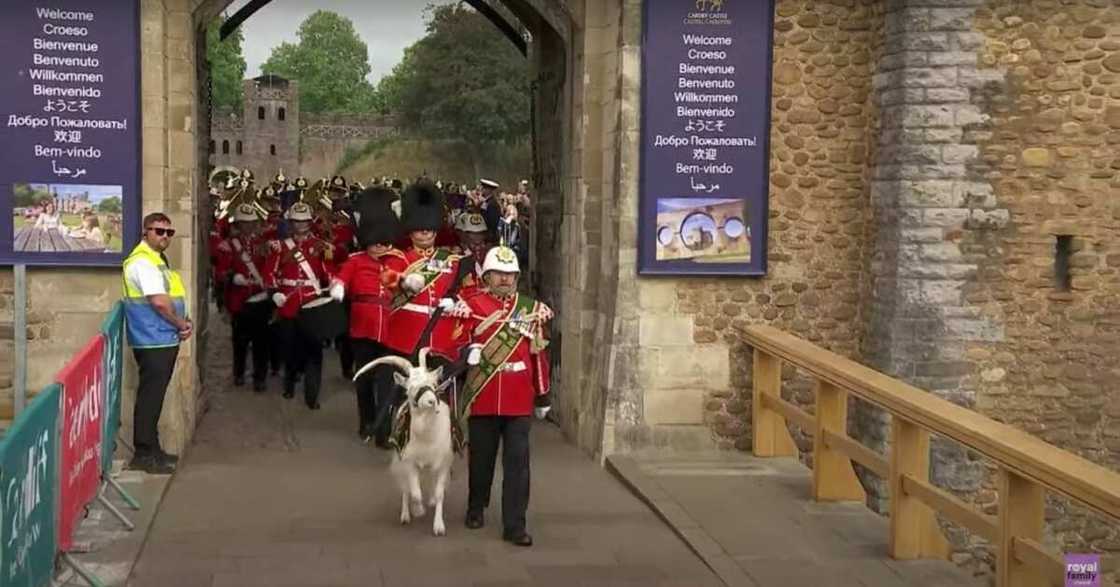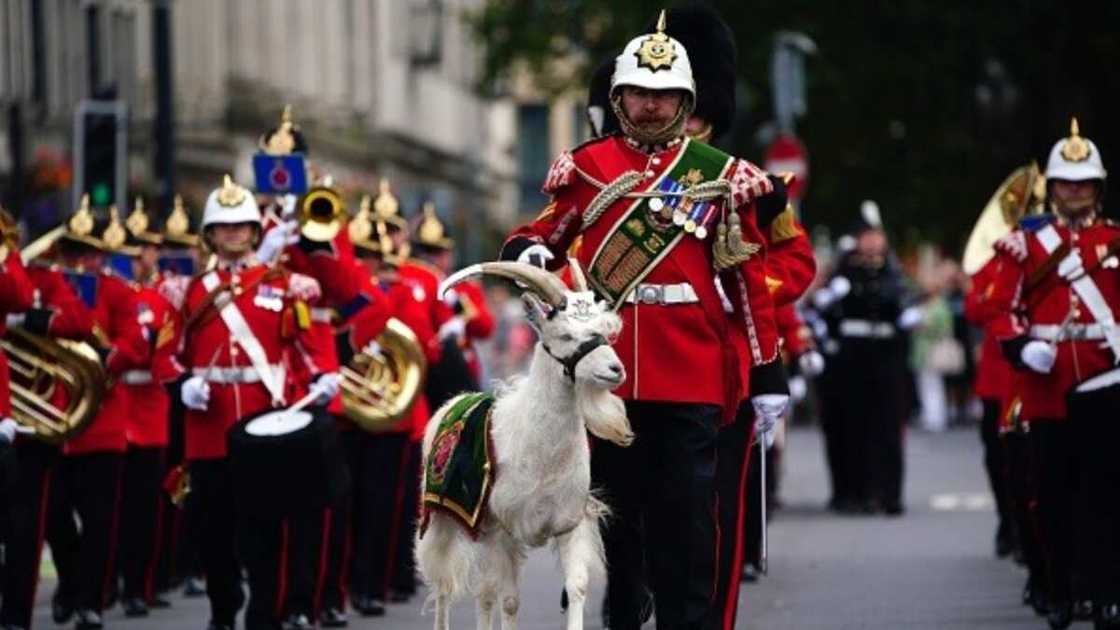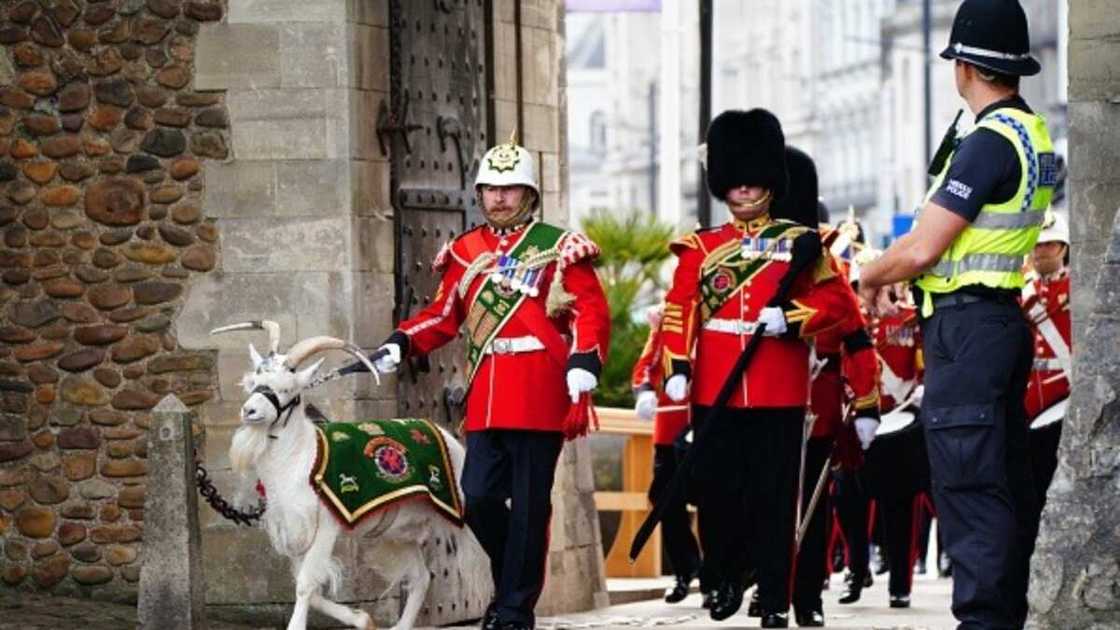Photo Shows "White Ram Intended for Sacrifice" for Crowning of Prince Charles as King of England?
A Nigerian Twitter user, Chuka Nduneseokwu, posted a thread of tweets claiming that a white ram in the attached photo was for "sacrifice" at the proclamation of Prince Charles as the King of England.
PAY ATTENTION: The 2024 Business Leaders Awards Present Entrepreneurs that Change Nigeria for the Better. Check out their Stories!
Nduneseokwu further claimed that it was the British "ancient tradition and culture".

Source: Twitter
Verdict: Is Nduneseokwu's claim true?
The claim that the alleged white ram in the attached photo in Nduneseokwu's tweet was for sacrifice at the proclamation of Prince Charles as the King of England is false.
First, the animal in the attached photo is a white goat. Also, the goat is not for sacrifice.
PAY ATTENTION: Share your outstanding story with our editors! Please reach us through info@corp.legit.ng!
Checks by Legit.ng indicate the goat is Lance Corporal Shenkin IV, the regimental mascot that accompanied the 3rd Battalion of the Royal Welsh regiment at the proclamation of King Charles III as the new monarch of England.

Read also
“Grace”: Dare Justified gushes as he, Moses Bliss, others become ambassadors to the city of Brampton
Full text: Alleged "white ram" sacrifice at King Charles' proclamation
On Wednesday, September 14, Chuka Nduneseokwu, a Nigerian Twitter user with the handle, @Chuka_ndu, posted a thread of tweets with a photo of an alleged "white ram".
Nduneseokwu claimed in his tweets that the supposed white ram was for "sacrifice" at the proclamation of Prince Charles as the King of England.
Nduneseokwu further claimed that it was the British "ancient tradition and culture".
The tweet reads:
"This is the British carrying a white ram (intended for sacrifice) for the crowning and declaration of Prince Charles as King of England.
"This is their ancient tradition and culture (Ọdịnaanị na Omenaanị as we call it).
"If this was an African king or chief, our brainwashed Christian brethren will call it idol worship, worshipping Alusi, and paganism.
"These are the same people that brought you the "church" and told you that your ways were evil.

Read also
Jubilation as Catholic priest installs solar-powered boreholes in 9 Imo villages, photos emerge
"They deceived you to abandon your ancient ways, only for them to hold unto their own. See them celebrate their own with pride. Africa wake up."
At the time of filing this report, the tweet has gone viral, with hundreds of retweets and shares across social media platforms and blogs.
Verification: Nduneseokwu's claim is false
To verify Nduneseokwu's claim, Legit.ng used Google reverse image search to confirm the authenticity of the photo.
The search indicates that the photo was authentic as similar versions were posted by other Twitter users and various media platforms.
However, the claim that the "white ram" was intended for sacrifice was false. The animal in the photo is named Lance Corporal Shenkin IV. It was not meant for "sacrifice".
Lance Corporal Shenkin IV is the regimental mascot goat which accompanied the 3rd Battalion of the Royal Welsh regiment at the Accession Proclamation Ceremony at Cardiff Castle, Wales, publicly proclaiming King Charles III as the new monarch.

Read also
"Preparing 4 his burial": Clip of Renovations going on at Junior Pope's country house stirs emotions
Prince Charles was officially proclaimed King Charles III of England on Sunday, September 11, following the death of his mother, Queen Elizabeth II.
Lance Corporal Shenkin IV: What to know about Royal Welsh's mascot goat

Source: Getty Images
Within many regiments in Wales, there is a history of having a mascot which for The Royal Welsh is a goat, according to the Royal Welsh Museum.
Legit.ng learns that the different antecedent regiments typically use the traditional names of Dewi, Taffy, Shenkin, and Sospan.
Like human soldiers, official mascots have a regimental number and rank. They can also be promoted and demoted and even receive a salary!
For the goat mascot, this salary goes towards his uniform, accommodation (which often includes a radio and a sofa) and food. Goat mascots are very well cared for by the Regiment.
According to the Musem, the Royal Welsh and its predecessor units have been adopting goats as their mascots since 1775, each with their own unique story of how they were acquired.
When the mascot dies, the regiment will write to the Queen (or King as is the case now) informing her of the loss and request permission to recruit a new mascot, continuing the tradition that began with Queen Victoria.
The next kid goat is selected and trained by the Goat Major who develops a close bond, with the kid accepting the Goat Major as the alpha.
This is a special relationship and a full-time role for the Goat Major requiring grooming, exercising, and training the kid on a daily basis.

Source: Getty Images
Conclusion: Alleged white ram not for sacrifice at King Charles' proclamation
The claim by Nduneseokwu that the goat seen with the Royal Welsh was meant for sacrifice at the proclamation of King Charles III is false.
The goat which Nduneseokwu erroneously described as a "white ram" is named Lance Corporal Shenkin IV and was not meant for "sacrifice".
Lance Corporal Shenkin IV is the regimental mascot goat which accompanied the 3rd Battalion of the Royal Welsh regiment at King Charles III's proclamation.
Tears as British public pays respects to queen's coffin
In another report, thousands queued overnight into Thursday, September 15, to pay their last respects to Queen Elizabeth II, with many choking back tears after seeing her coffin lying in state in London.
Britain's longest-serving monarch, who died on September 8 aged 96 after 70 years on the throne, is at rest in the capital's Westminster Hall ahead of Monday's state funeral at Westminster Abbey.
After waiting in all weathers for more than 48 hours, the first public mourners were allowed into the vast mediaeval hall on Wednesday after the coffin left Buckingham Palace for the last time, in a ceremonial procession witnessed by tens of thousands.
PAY ATTENTION: Unlock the best of Legit.ng on Pinterest! Subscribe now and get your daily inspiration!
Source: Legit.ng




